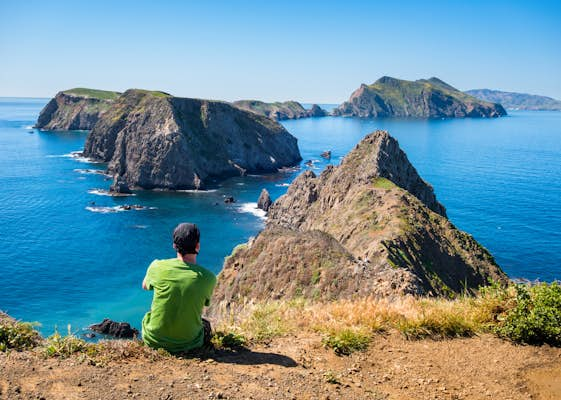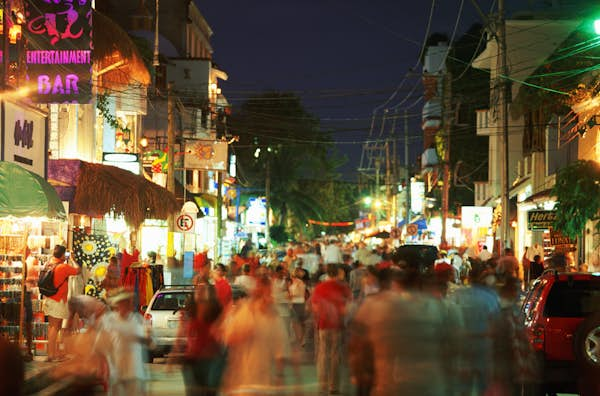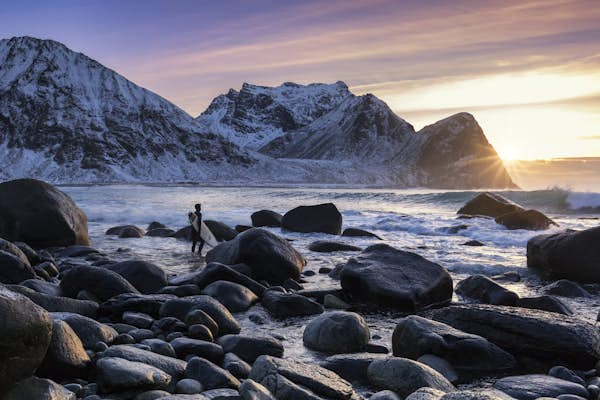Hovering just off the coast of Southern California are a string of under-explored islands that offer a peaceful escape from the noise and hubbub of the mainland. If you fancy camping in serene scenery in front of epic sunsets, look no further than California’s Channel Islands.
The eight Channel Islands earn every bit of their ‘North America’s Galapagos’ nickname – more than 150 endemic species of plants and animals are tucked onto these specks of land scattered across the bay between Santa Barbara and San Diego.
For nearly 13,000 years, these islands have stayed largely aloof from domestication, and even from tourism, with one notable exception. This is all rather surprising given that the isles lie within sight of one of the most densely populated parts of the US.
While the island of Santa Catalina is fairly well-known and developed, the other Channel Islands are still wonderfully unspoiled. And while a visit is not as easy as say, a trip to Disneyland, you can have a meaningful experience even on a short day trip from a Southern California harbor.
Here’s how to experience each of the eight islands, starting with the five islands protected as the Channel Islands National Park.
Channel Islands National Park
While the Channel Islands archipelago stretches from Santa Barbara County all the way south to the fringes of San Diego, the five national park islands are more tightly grouped off the shore near Ventura. The National Park Service (NPS) keeps the human impact on these hilly islands to a bare minimum to preserve their raw and natural character.
The islands are mostly treeless with little cover from the near-constant winds, but the wildflowers in spring are superb, as is the hiking year-round. Rangers and volunteers run guided hikes timed to meet some, but not all, boat trips – the NPS operates visitor centers in Santa Barbara and Ventura where you can make inquiries.
Each of the islands has a small, primitive campground with pit toilets and not much else. Everything has to be packed in and out, including water (unless you are staying at the sites on Santa Cruz or Santa Rosa). Make camping reservations with the NPS in advance to secure a spot.
Island Packers runs boat services to the park from Ventura Harbor and nearby Oxnard, and you can take day trips most days to Anacapa and Santa Cruz islands. Boats run less often to Santa Rosa and San Miguel and there are currently no boats to Santa Barbara (though services may resume once the jetty is repaired). Other ways to reach the islands include private boat charters and multi-day cruises, some focusing on diving in the rich and pristine waters of the national park.

If you’re camping, consider bringing along TC Boyle’s 2011 book When the Killing’s Done – part murder-mystery, part environmental parable about an eccentric man’s efforts to prevent the NPS from clearing invasive pigs and rats from the Channel Islands. It was inspired by the ongoing and controversial efforts to remove non-native species introduced by past settlers, which now threaten the fragile environment and endemic species.
Note that from June to November, the Santa Barbara Channel is home to the largest population of blue whales in the world outside of Antarctica. Trips to the islands during these months often include time for whale-spotting. Other whale species spotted here include humpbacks, grey, fin, and minke whales, dolphins and orcas.
Santa Cruz
Best for active day trips for hiking and kayaking
At 96 sq miles, Santa Cruz is the largest and most varied of the Channel Islands. With two rugged mountain ranges – including 2450ft Mt Diablo, the park’s tallest peak – and a picturesque central valley, plus 77 miles of coastal cliffs and abundant native plant and animal life, it’s a beacon for hikers and campers.
Wildlife spotters may encounter its two best-known inhabitants, the scrub jay and the island fox. While distinct subspecies of this charmingly fearless diminutive fox species are found on six of the Channel Islands, the monogamous scrub jay lives only on Santa Cruz.
The NPS website details the island’s 10,000-year history of human settlement, and there are upwards of 3000 archaeological sites. Look for collections of broken shells lying on the ground away from the ocean for evidence of ancient human activity.
Top Tip: Take a water-based excursion to view the painted cave, a sea cave with striking colors created by algae, lichen and different rock types.
Getting there: There are two landing spots on Santa Cruz: Scorpion and Prisoners Harbor. Scorpion is the main landing site and it takes a little over an hour to get here from Ventura. There are normally several boats daily.
Camping: Reserve the camping site at Scorpion Canyon well in advance via the NPS; this is a popular island and spaces fill up quickly in season. Potable water is available.
Anacapa
Best for easy day trips with stunning views
Fittingly named Anayapax, meaning ‘illusion’ or ‘mirage’ in the language of the Chumash, the island’s original inhabitants, Anacapa is actually a three-islet sliver of land lying 11 miles from the mainland. Wildflowers abound and ground-nesting western gulls greet spring and summer visitors. Their eggs and chicks are safe because Anacapa is naturally predator-free.
Easy year-round hikes lead to a stolid 1932 lighthouse and mind-boggling westward and mainland views. Keep an eye out for sightings of the endemic Anacapa deer mouse and Channel Island slender salamander.
Top Tip: Look for abalone shells left by the Chumash people up to 5000 years ago.
Getting there: Boat trips taking one-hour leave most days from Oxnard on the mainland.
Camping: The campsites are a half-mile climb up 157 stairs from the boat landing site, and you’ll need to bring water.

San Miguel
Best for observing seals and sea lions
Known for being wind-swept, foggy and cold, San Miguel is at its best on sunny summer days, when the island’s 30,000 pinnipeds – including northern elephant seals, California sea lions, northern fur seals and harbor seals – haul up on the shores. You can see tons (literally!) of them lounging around at Point Bennett, reached via a 16-mile ranger-led hike.
Along the way, you’ll pass the ghostly Caliche Forest, composed of calcium carbonate casts of roots formed around 14,000 years ago. Keep an eye out for endemic flora such as giant coreopsis, poppies, dudleya, locoweed and buckwheat. Native species are making a comeback since the removal of non-native grazing animals such as voracious goats and other feral livestock.
Top Tip: San Miguel has the toughest weather of all the Channel Islands – 30mph winds are typical, so bring appropriate clothing.
Getting there: It takes around 3½ hours to reach San Miguel from Ventura and there are only two dedicated day trip services each year. Boats for campers run two to three times per week but only during certain months (see the Island Packers website for details). There is no pier, so expect to get wet getting to shore.
Camping: The San Miguel campsites are a steep 1¼-mile hike from the beach landing site, and you must bring your own water.
Santa Rosa Island
Best for beach fun and hiking to see spring wildflowers
Set out on one of the trails crossing 84-square-mile Santa Rosa Island and imagine how it must have felt to be the archaeologist who discovered 13,000-year-old human bones here — the oldest human remains ever found in North America. This part of America looked very different at the time; if you scour the eroding cliffs, you may find evidence of extinct pygmy mammoths.
For more recent history, you can visit bunkhouses, corrals and ranch houses located near the pier – a reminder of the days when livestock still grazed this former cattle ranch and the island was used as a big game hunting park.
Nature has bounced back impressively and you can search for Channel Island natives such as the cute (and potentially stinky) island spotted skunk, the non-venomous dwarf island gopher snake, and the island fence lizard. Take time to explore the grove of Santa Rosa Island Torrey Pines — the world’s rarest pine tree, and a relic from an ancient Pleistocene-era forest. These gnarled survivors grow to about 50 feet tall.
Top Tip: Don’t miss the hike along Water Canyon Beach, a spectacular and nearly deserted two-mile strip of white sand directly south of the landing pier.
Getting there: It’s a 2- to 3-hour boat ride to the island from Ventura. The service for campers runs a couple of times per week, and there are infrequent day trips.
Camping: The campsite is a flat 1½-mile walk from the pier and there’s potable water.

Santa Barbara Island
Best for spotting sea birds and solitude
One-square-mile Santa Barbara Island is the smallest Channel Island and the least visited island in the national park, seen by fewer than 750 people annually. This means visitors can enjoy its five miles of rolling trails in near solitude.
Circumnavigate this steep-sided isle for sightings of pinnipeds and the islands’ three endemic subspecies of land birds, or head up 634ft Signal Peak for stunning views of Sutil Island – and a chance of spotting a resting peregrine falcon.
The island is a critically important nesting ground for at least 11 species of seabirds, with one of the world’s largest congregations of Scripps’s murrelets. Sharp-eyed springtime visitors can spy young California brown pelicans, western gulls and multiple species of cormorants and storm petrels. Tropical brown boobies have started making regular appearances too, and have hatched at least one chick on Sutil.
Top Tip: This is an island for those who really want solitude – contemplate the splendid isolation at the north end of the island, where a lonely rock arch juts into the bay.
Getting there: Severe storm damage to the island’s wooden dock means that there is currently no scheduled service to the island, although you may be able to charter a boat and land on a rocky ledge. Check in with Island Packers to see when scheduled boat services are set to resume.
Camping: The campground is reached via a 200ft walking path from the landing point, and you may have to shoo away some lounging sea lions to get there. You’ve been warned!
Non-National Park Channel Islands
There are more islands beyond the national park boundaries. Santa Catalina is a busy vacation spot, and nearby are San Nicolas and San Clemente, which you can only view from the water on boat trips.

Santa Catalina
Best for creature comforts and bison!
From 1911 onwards, Hollywood stars started flocking to Catalina Island for sportfishing and expensive nights out at the red-roofed art deco casino at Avalon, occasionally leaving behind movie extras, including a herd of live bison. Now stars in their own right, the bison still wander the hillsides, delighting visitors who chance across them.
Sporty types love Avalon for its outdoor activities, city-center beach, dining and lodging options, and sporting history. Baseball fans can visit the site of the original Wrigley Field, where the Chicago Cubs trained for 30 years from 1921 to 1951 (with a gap during WWII). It’s now a public golf course.
On the narrow isthmus that almost divides the island in two, the village of Two Harbors offers the opportunity to get away from the Avalon bustle and camp in relative peace and quiet.
Top Tip: Rent a golf cart to get around, instead of a car; this isn’t an island where you need to rush.
Getting there: Fast and slow ferries run daily from Long Beach, Dana Point and San Pedro. The glitterati opt for pricey helicopter transfers.
Where to stay: There are many options on Catalina, from upscale hotels to less expensive B&Bs. Camping is possible in Avalon and Two Harbors.
San Nicolas and San Clemente Islands
Best for diving
The public is barred from landing on these US naval base islands, but scuba diving, boating and swimming in approved waters are okay and many boat trips run out here from the mainland. Before becoming a launch platform for missile testing, San Nic was home to the ‘Lone Woman of San Nicolas Island,’ the last Native American to live on the islands and the inspiration for Karana, the heroine of Scott O’Dell’s Newbury-award-winning novel, Island of the Blue Dolphins.
San Clemente is the southernmost Channel Island, and it’s an important elephant seal rookery. This is also the spot where human Navy SEALs train for missions, such as the raid against Osma Bin Laden’s compound in Pakistan, for which a replica was built on the island. It’s also a naval ship-to-shore firing range.
Getting there: The only way for civilians to visit is on scuba diving, fishing and boating trips arranged through commercial operators on the mainland.
Portions of this article appear in Corinne Heyning Laverty’s book, North America’s Galapagos: The Historic Channel Islands Biological Survey. University of Utah Press, December 2019
This article was first published Aug 15, 2019 and updated May 27, 2024.




